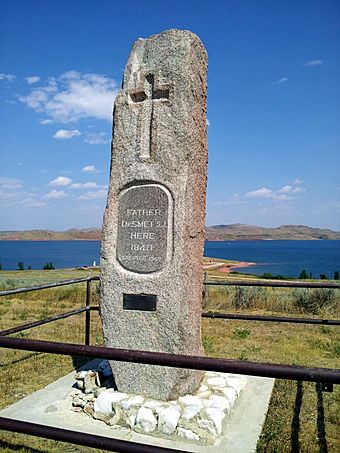Lake Desmet Segment, Bozeman Trail facts for kids
Quick facts for kids |
|
|
Lake Desmet Segment, Bozeman Trail
|
|
 |
|
| Lua error in Module:Location_map at line 420: attempt to index field 'wikibase' (a nil value). | |
| Nearest city | Buffalo, Wyoming |
|---|---|
| Area | 258 acres (104 ha) |
| MPS | Bozeman Trail in Wyoming MPS |
| NRHP reference No. | 89000814 |
| Added to NRHP | July 23, 1989 |
The Lake Desmet Segment is a special part of the Bozeman Trail in Johnson County, Wyoming. It's a one-mile stretch where you can still see the old wagon ruts! These ruts are very well-preserved and are located about a mile west of Lake Desmet. Since this area is on private land, you need permission to visit.
About Lake Desmet
Lake Desmet is a natural lake located between Piney Creek and Boxelder Creek. It's one of several lakes in the Buffalo area that formed in a unique way. Long ago, underground coal seam fires burned away coal deposits. When the coal was gone, the ground above it collapsed, creating these natural basins where water could collect.
When it first formed, Lake Desmet had very salty water, so not many plants or animals could live there. But between 1880 and 1915, there was a lot more rain. This extra water flowed into the lake, making it less salty.
Over the years, people have changed the lake. In 1917, a rich man named Levi Leiter built a ditch to bring more water from Piney Creek into the lake. He also built a small dam. Later, in 1957, Reynolds Mining bought the lake. They replaced the ditch with a tunnel and built a taller dam. Then, in 1976, Texaco bought the lake and made the dam even higher. The original lake was about 1,500 acres, but now, because of these dams, it's grown to about 3,600 acres!
History of Lake Desmet
Lake Desmet was first written about by Pierre-Jean De Smet, a Jesuit priest and missionary to Native American people. He described the lake in a letter from August 24, 1851:
"On the 23rd we left Tongue River. For ten hours we marched over mountain and valley, following the course of one of its tributaries, making, however, only about twenty-five miles. On the day following we crossed a chain of lofty mountains to attain the Lower Piney Fork, nearly twenty miles distant. We arrived quite unexpectedly on the borders of a lovely little lake about six miles long, and my traveling companions gave it my name. There our hunters killed several wild ducks."
In 1865, the Powder River Expedition, a military group, passed by Lake Desmet while operating against the Sioux Indians. One of the officers, Captain Henry E. Palmer, also described the lake:
"Seven miles from Clear Fork, we came to a very pretty lake about two miles long and about three-fourths of a mile wide, which Major Bridger (Jim Bridger) told us was De Smet Lake, named after Father De Smet. The Lake is strongly impregnated with alkali, in fact, so strong that an egg or potato will not sink if thrown into the water. Large, red bluffs are to be seen on both sides and underneath the lake is an immense coal vein."
The famous Bozeman Trail was used from 1863 to 1868. It passed about a mile west of Lake Desmet, running along the lake's side. About half a dozen travelers who kept diaries mentioned the lake. Some of them even mistakenly called it Smith or Smith's Lake.
Over the years, there have been many stories that Lake Desmet is home to a sea monster! These legends and even some recent sightings have continued to this day.
Even though Father De Smet spelled his name differently, the lake is usually spelled Lake Desmet.

